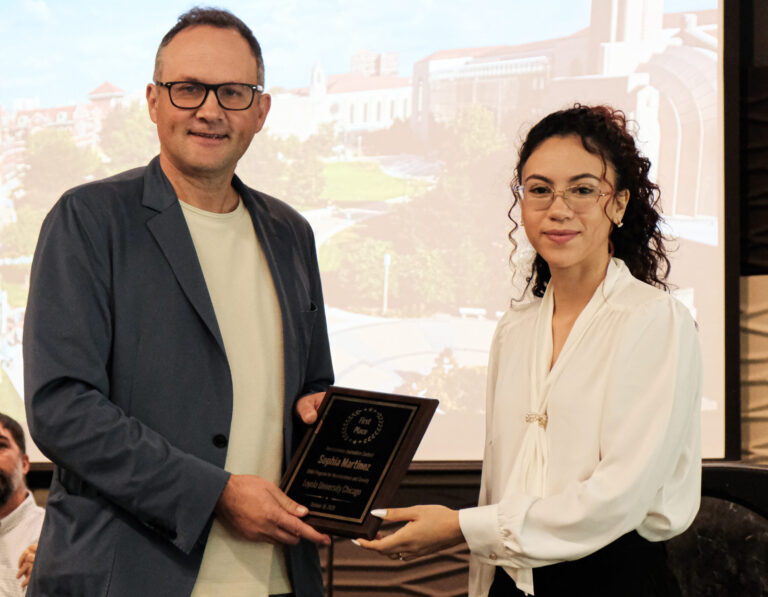Journalists and scientists gathered at the Science Journalism in a Post-Truth World in the Damen Den Oct. 14 to discuss how the decline in science coverage has deepened the public’s mistrust and misunderstanding of science.
Science journalism once held a prominent place in media. Since then, science journalism has largely disappeared from mainstream media — and experts say the consequences are serious.
During the event, environmental journalist for the Chicago Tribune Adriana Pérez described how 50 years ago the Chicago Tribune had a dedicated staff writing for the “science only” section. Their coverage of scientific journalism drew nationwide acclaim. Today, there are only two full time journalists reporting on the former science only, now environmental desk.
The discussion followed the award ceremony for the 2025 DANA Program for Neuroscience and Society’s annual Neuroscience Journalism Contest, which awarded students for neuroscience and its relevant application to the world through discussion of neuroscientific studies, policy issues and discoveries, The Phoenix reported.
In first place was University of South Florida undergraduate student Sophia Martinez, in second place was Rutgers University-Camden undergraduate student Tiffany Chan and in third place was Brown University undergraduate student Jeffery Mu.
The DANA Program for Neuroscience and Society is a two-year long project funded by the DANA Foundation and Loyola. The program is student focused to raise STEM awareness in K-12 students under the instruction of Loyola professors. Students are taught about neuroscientific concepts, STEM careers and neuroethical issues through an Ethics-based Teaching Helps Optimize Stem (ETHOS) approach.
The panel discussed the importance of science journalism in society and the crucial role journalists hold writing stories about science for the public to learn and gain awareness about science to inform scientific policies voted on by the public.
“I really, really, really believe that the work done in a lab by students, or the work of researchers on campus, are doing a human story and bringing those human stories to the forefront is what helps draw audiences, to arouse their curiosity,” science journalist, editor and instructor at Northwestern University Carolyn Wilke said.
Wilke said human connection isn’t only vital in the subject of the stories but in the process of scientific reporting between scientists and journalists who require improved communication efforts.
The public often struggles to understand scientific findings because of the field’s complex jargon, according to Loyola biology professor Thomas Sanger. Journalists play a crucial role in translating that language, making scientific information accessible and clear, said Sanger.
Sanger spoke from the perspective of scientists and said they need to know interviews on their work are a “two-way street.” Sanger said scientists need to take a step back and realize journalists aren’t as knowledgeable on their topic of research as they are.
“It’s not about educating as much as they want to hear the way you phrase something, or the way you distill complexity down in a way that hopefully people will find interesting,” Sanger said.
In turn, journalists must lie out the ground rules of an interview, context or angle of their story to gain the trust of scientists, according to accomplished science podcaster and writer Sadie Witkowski. Witkowski said scientists are unfamiliar with journalistic processes like fact checking, being quoted as primary or secondary sources, or not allowing the public or sources to review articles before publishing.
“I think in the beginning of a conversation, setting some of those expectations for someone you’re interviewing, whether they’re a scientist or not, saying like ‘Hey, I’m going to record this conversation, you know, this is all on the record,’” Witkowski said.
Discrepancies in reporting between scientists and journalists aren’t the only challenges faced in science journalism. Mainstream media outlets and newspapers are lessening their coverage of science and leading to a shift in different mediums of reporting.
Adriana Pérez said despite being an environmental science reporter,’ she’ll often cover all science stories at the Tribune due to staff shortages.
“I think there’s definitely still a hunger from audiences. It’s just maybe legacy media is not prepared to continue fulfilling that need,” Pérez said.
The challenges faced by mass media have raised the question of who will bear the responsibility for accurate scientific reporting. One proposed solution is for academia to take a more active role in sharing its own research, according to Principal Investigator of Loyola’s neuroscience and society program Bill Rochlin. Particularly by engaging journalism students within universities to cover and communicate their institutions’ scientific discoveries, Rochlin said.
A hurdle student journalists face when covering scientific journalism is the technicality of the subjects they’re covering and the field of science as a whole, according to writer for Science American, The Wall Street Journal, The New York Times for Kids, and journalism instructor at Loyola Susan Cosier.
Cosier said during one’s undergrad experience everyone is studying their specialized subjects and not every student is proficient in everything. She said it’s okay to not perfectly comprehend it all.
“We are discovering new things all the time,” Cosier said. “ You shouldn’t see science as a closed door that you have to know everything in the world about in order to open. There is a need for people to be able to explain some difficult scientific discoveries or concepts or ideas in ways that everybody can understand.”
Images are for reference only.Images and contents gathered automatic from google or 3rd party sources.All rights on the images and contents are with their legal original owners.
